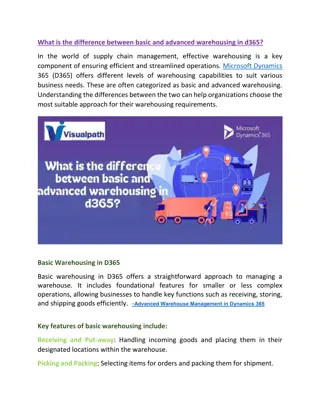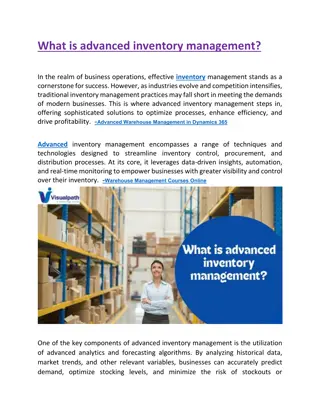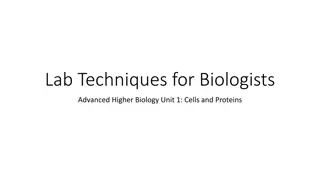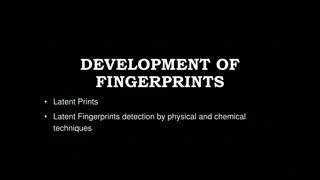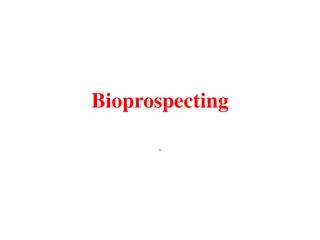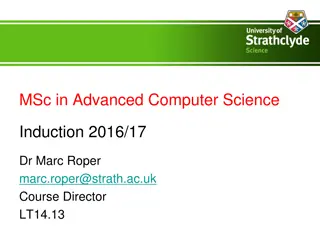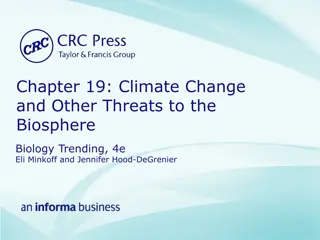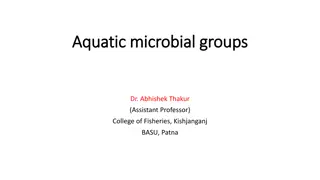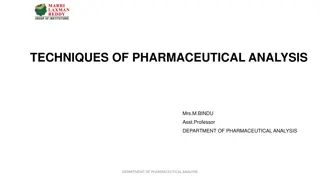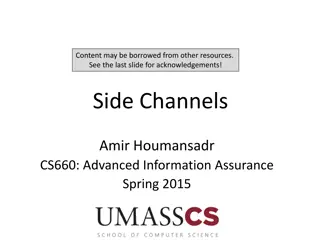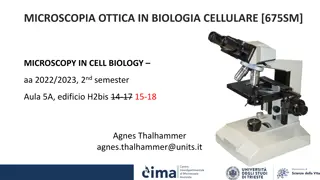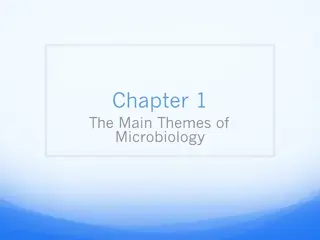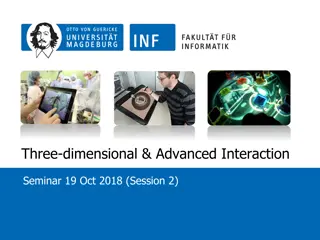
Advanced Techniques in Molecular Biology Workshop at Godfrey Okoye University
Explore bioremediation strategies using DNA technology to address polluted environments, with a focus on natural attenuation, biostimulation, and bioaugmentation. Discover the role of microbial organisms in degrading contaminants and enhancing environmental safety.
Download Presentation

Please find below an Image/Link to download the presentation.
The content on the website is provided AS IS for your information and personal use only. It may not be sold, licensed, or shared on other websites without obtaining consent from the author. If you encounter any issues during the download, it is possible that the publisher has removed the file from their server.
You are allowed to download the files provided on this website for personal or commercial use, subject to the condition that they are used lawfully. All files are the property of their respective owners.
The content on the website is provided AS IS for your information and personal use only. It may not be sold, licensed, or shared on other websites without obtaining consent from the author.
E N D
Presentation Transcript
Workshop on Advanced Techniques in Workshop on Advanced Techniques in Molecular Biology: Operationalizing Your Molecular Biology: Operationalizing Your Molecular Biology Laboratory Molecular Biology Laboratory Venue: Godfrey Okoye University, Thinkers Corner, Ugwuomu-Nike, Enugu Date: 18 - 22 July, 2016 DR. C. O. ONYIA BIOTECHNOLOGY AND APPLIED BIOLOGY DEPARTMENT GODFREY OKOYE UNIVERSITY ENUGU
Application Application of DNA Technology in Bioremediation of Polluted of DNA Technology in Bioremediation of Polluted Environment: Crude Oil Contaminated Soil and Water Environment: Crude Oil Contaminated Soil and Water Bioremediation is defined as the process by which microorganisms are stimulated to rapidly degrade hazardous organic pollutants to environmentally safe levels in soils, sediments, surface and ground water. Micro-organisms are known to be the principal agents, which can clean and modify the complex lipophilic organic molecules, once considered recalcitrant, to simple water soluble products.
BIOREMEDIATION STRATEGIES BIOREMEDIATION STRATEGIES THERE ARE THREE TYPES OF BIOREMEDIATION STRATEGIES INVOLVING MICROORGANISMS: NATURAL ATENUATION BIOSTIMULATION BIOAUGMENTATION
NATURAL ATTENUATION Natural populations (indigenous bacterial consortia) adapt to the existing conditions in the contaminated environment to convert the contaminants to non-hazardous end- products rapidly enough to prevent downstream impact
BIOSTIMULATION Natural populations can be stimulated to degrade contaminants by nutrients enrichment. Anaerobic respiration is a common process by which organisms degrade contaminants, through the electron donors or electron acceptors needed by the organism to complete the decontaminating reaction.
BIOAUGMENTATION In some cases it is necessary to add the microbial organisms that are capable of degrading the contaminant or boost the population of the resident microorganisms.
CRUDE OIL Crude oils are natural products, derived from photosynthetic organisms (ancient algae and plant materials) that were buried deep in the earth and heated at great pressure over millions of years, giving rise to oil in which is stored the energy generated by the photosynthetic activity. Photosynthetic organisms use energy from the sunlight to convert carbon dioxide and water into carbohydrates, proteins and fats, with oxygen as a by-product. Energy is stored in the newly formed chemicals. When the organisms die and are buried in sediments, the heat and pressure deep underground convert the chemicals into variety of hydrocarbon compounds containing carbon and hydrogen.
Hydrocarbon Hydrocarbon Degradation Degradation The energy stored in the chemical bonds can be released by burning, which is similar to what happens in chemical reaction carried out by enzymes inside living cells. These enzymes enable microorganisms to combust the hydrocarbons at much lower temperatures than burning. Over millions of years, microorganisms have evolved catalytic enzymes that are specific for particular degradation reactions. The bacterial cell harnesses the energy released by degrading the compounds to support its own life processes. Biodegradation of aromatic hydrocarbons is usually carried out by consortium of microorganisms, as no single bacterium can produce all the necessary enzymes to degrade the long chains of hydrocarbon.
CONDITIONS FOR EFFECTIVE MICROBIAL HYDROCARBON DEGRADATION: CONDITIONS FOR EFFECTIVE MICROBIAL HYDROCARBON DEGRADATION: ENVIRONMENTAL FACTORS FOR OPTIMAL PERFORMANCE ENVIRONMENTAL FACTORS FOR OPTIMAL PERFORMANCE Physical nature of the oil: High volume oil spill provides less surface area for microbes to gain access to the oil, making degradation slow. If the oil is heavy and viscous, the biodegradable components must first diffuse through the thick matrix to the oil-water interface so that the microbes can have access to them, The lighter the oil, the faster the diffusion, making the biodegradable compounds more available to the microorganisms. Chemical nature of oil: Biodegradation rates vary depending on the particular hydrocarbons that make up the spilled oil. The hydrocarbons with unbranched carbon chain are easier and quicker to degrade; the polycyclic aromatic compounds, which have their carbons arranged in multiple rings, are far more difficult to degrade. Availability of nutrient: Microorganisms require nutrients to perform and survive, these include- nitrogen, phosphate among others. Where the nutrient is limiting, biodegradation take place more slowly
CONDITIONS FOR EFFECTIVE MICROBIAL HYDROCARBON DEGRADATION: CONDITIONS FOR EFFECTIVE MICROBIAL HYDROCARBON DEGRADATION: ENVIRONMENTAL FACTORS FOR OPTIMAL PERFORMANCE ENVIRONMENTAL FACTORS FOR OPTIMAL PERFORMANCE Availability of oxygen: The enzymatic process of biodegradation is faster in the presence of oxygen; Water temperature: Generally, oil is more quickly degraded in warm waters than in cold waters. Pressure: Biodegradation takes place in ultra deep waters, below the seabed (e.g. Deepwater horizon, where temperature is low and pressure is high) by oil-degrading microbes that have adapted to these extreme conditions. pH and salinity: In most of the ocean, pH and salinity do not vary enough to make a big difference in oil degradation rates. Some environments, like salt marsh sediments, exhibit not only high salinity, but also rapid fluctuations in salinity, oxygen, and pH-all characteristics that typically slow oil degradation.
CHALLENGES CHALLENGES In natural environment, the microbial consortia (not individual microbe) are involved in degrading the various constituents of the oil; Natural selection has been acting on the environmental microbes for billions of years, chatting (honing) the effective metabolic pathways for degradation of hydrocarbons; The bioengineered strain will have to out-compete the indigenous, resident microbes that are well adapted to the environment to perform;
CHALLENGES CHALLENGES The microbes may need to be engineered to function in different habitats with extreme environmental conditions such as extreme pH, temperature, salinity, drought situation, etc; Gene stacking may be an option, but a daunting exercise
BIO BIO- -ENGINEERED MICROBES ENGINEERED MICROBES Genes have been manipulated by man for a very long time. From the early days of Gregor Mendel, selective breeding was used to bring out interesting, useful and sometimes unusual traits in plants and other organisms. It has been proposed that the exchange of genetic information between organisms in nature is considerably more commonplace than is generally imagined. It is possible to engineer microbes that show enhanced oil degrading capabilities in the laboratory. Most of the demonstrations of the efficacy of genetically engineered microorganisms in bioremediation of contaminated environment are in the laboratories.
TRANSFORMATION TRANSFORMATION Genetic alteration of a cell as result of direct uptake or incorporation of exogenous DNA from its surrounding through the cell membrane. This process can occur naturally in some species of bacteria or effected artificially in some other cells. For transformation to happen, bacteria must be in a state of competence, which might occur as a time-limited response to environmental conditions such as starvation and cell density.
PLASMIDS PLASMIDS AND BACTERIOPHAGES BACTERIOPHAGES. In bacteria, the most likely candidates for genetic transfer are plasmids and bacteriophages. A plasmid is a small, circular, double stranded DNA molecule within a bacterial cell that is physically separated from a chromosomal DNA, which is capable of independent replication. While the chromosomes are big and contain all the essential information for living, plasmids usually are very small and contain only additional information. Artificial plasmids are widely used as vectors in molecular cloning, serving to drive the replication of recombinant DNA sequences within host organisms. Plasmids can be transmitted from one bacterium to another (even of another species) via three main mechanisms:
Transduction AND Conjugation Transduction AND Conjugation Transduction: Injection of foreign DNA into the host bacterium Conjugation: Transfer of genetic material between two bacterial cells in direct contact The host-to-host transfer of genetic material is known as horizontal gene transfer, Plasmids provide a mechanism for horizontal gene transfer within a population of microbes and typically provide a selective advantage under a given environmental state. They may carry genes that provide resistance to naturally occurring antibiotics in a competitive environmental niche, or Produce proteins that may act as toxins under similar circumstances, or allow the organism to utilize particular organic compounds that would be advantageous when nutrients are scarce.
Manipulation of Bacteria by Genetic Engineering Manipulation of Bacteria by Genetic Engineering Genetic manipulation is the deliberate introduction of defined genes into a specified organism is in constant development. The techniques have produced some exciting hybrids in all areas of research, both microscopic - bacteria and fungi, usually described as recombinants, and macroscopic-higher plants and animals known as transgenes. The latter term refers to the principle of deliberate transfer of a gene from one organism to another in which it is not normally resident. This earns the incoming gene the title of foreign gene .
Basic Principles of Genetic Engineering Basic Principles of Genetic Engineering Basic cloning procedures share some fundamental requirements and include: Enzymes, solutions and equipment necessary to perform the procedures; the desired piece of DNA to be transferred; cloning vector; the recipient cell which may be a whole organism; marker genes
THE DEVELOPMENT OF FIRST SUPERBUG FOR BIOREMEDIATION THE DEVELOPMENT OF FIRST SUPERBUG FOR BIOREMEDIATION
Transformation Processes Figure 2: Illustration of Transformation Process: NOTE "Transformation" may also be used to describe the insertion of new genetic material into non-bacterial cells, including animal and plant cells; transformation has a special meaning in relation to animal cells, indicating progression to a cancerous state, the term should be avoided for animal cells when describing introduction of exogenous genetic material, The term transfection should be used when describing introduction of foreign DNA into eukaryotic. Gene from bacterial cell 1 moved to cell 2 followed by integration of the new trait into the new cell
LUX Gene Construct LUX Gene Construct


